Fritillary: care, planting, growing and varieties
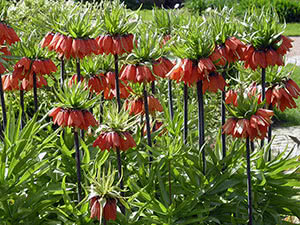 Fritillary (lat. Fritillaria) is a genus of herbaceous perennials in the family Liliaceae. In the wild, there are about one hundred and fifty species of plants growing in the temperate zone of the Northern Hemisphere, in Eastern or Western Asia. The fritillary plant received its name because the shape of the flower corolla resembled a box in which dice were carried and in Latin it was called “fritillus”.
Fritillary (lat. Fritillaria) is a genus of herbaceous perennials in the family Liliaceae. In the wild, there are about one hundred and fifty species of plants growing in the temperate zone of the Northern Hemisphere, in Eastern or Western Asia. The fritillary plant received its name because the shape of the flower corolla resembled a box in which dice were carried and in Latin it was called “fritillus”.
Description of fritillary flowers
The flowers of fritillary look like a small palm tree with the flowers at the top, and they are often called “paradise trees”. The bulbs of fritillary consist of several broad fleshy scales that are annually renewed. There are no covering scales, therefore the bulbs require a very careful treatment. The ground stalk is covered with numerous narrow-lined or oblong-lanceolate leaves with verticillate or intersperse arrangement. The flowers can be pendant, solitary or collected in an umbrella or panicle. They attract attention with bright perianth of yellow, purple, white or red colors. Fritillaries are ephemerals: at the base of each leaf there is a nectarial pit of an oval, of round or triangular shape. The fruit of fritillary is a six-sided capsule with numerous seeds, it can be winged or wingless.
Species and varieties of fritillary
It is not that the classification of fritillary is very difficult, but it is the task for scientists to study it. We will make a general overview and focus on those species and varieties that are of interest to a large number of amateur flower growers. So fritillaries are divided into six sections:
Section I Eufritillaria in its turn, consists of four groups that include species originating from the Mediterranean, West Asia and Western Europe. The most outstanding representative is snake’s head fritillary: it has been cultivated since 1572, named so because of its snakelike appearance. Its height is up to 13.7 inches, the flowers are solitary, two bell-shaped flowers occur very rarely, nodding flower heads have a checkered pattern. It is a minimal care plant, has many garden forms and varieties: Alba, Aphrodite are white-flowered varieties, Artemis is purple with green, Jupiter has very large dark-red flowers.
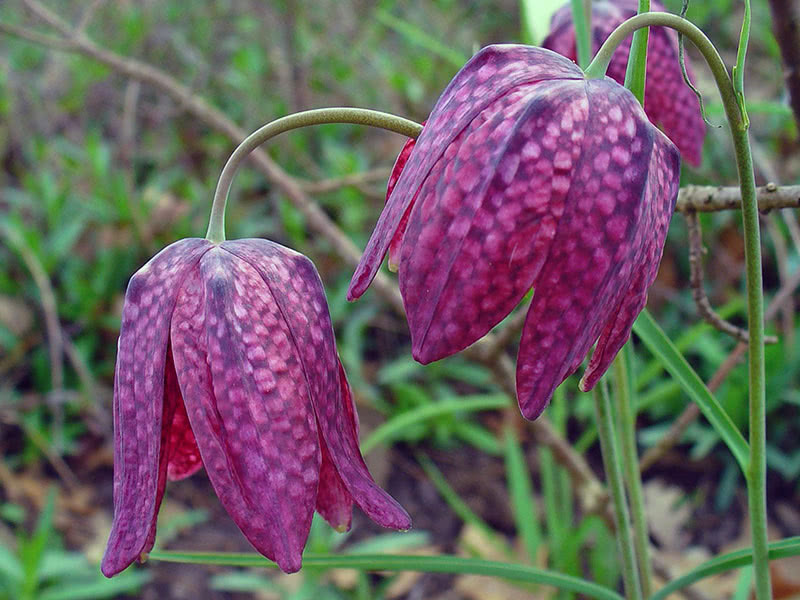
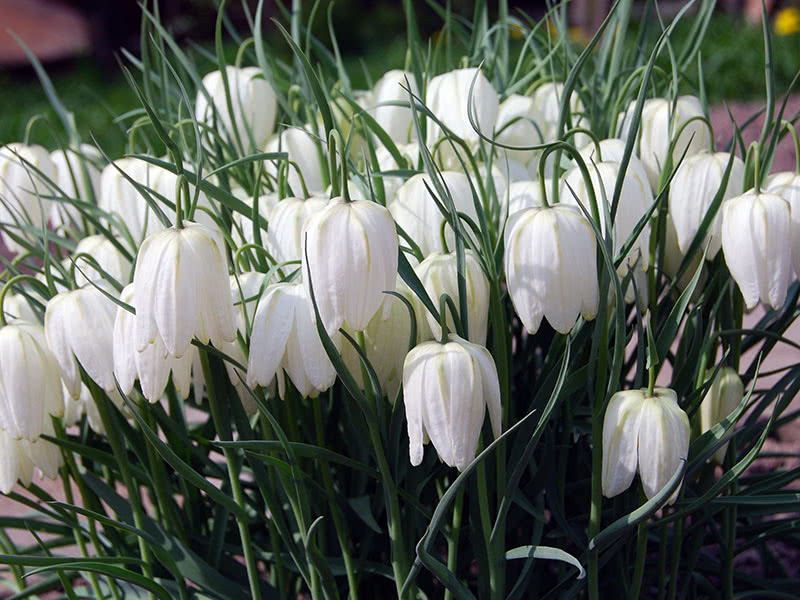
In addition, this group includes such species as fritillaria michailovskyi (Michael’s flower), fritillaria caucasica, pointed-petal fritillary, fritillaria meleagroides, yellow fritillary, fritillaria montana and others.
Section II Petilium includes species of large fritillaries, native to the Western Himalayas, Turkey, Northeast Iraq and Turkmenistan. The most outstanding representative of this group is famous crown imperial, or imperial fritillary. Imperial fritillary comes from Turkey, and it was brought to Europe in 1580, and now there are about 20 forms of this species. Its bulbs have an unpleasant smell, the height of stalk is up to 3.3 ft, the leaves are whorled, broad-lanceolate, the nodding bell-shaped flowers are up to 2.4 inches in diameter, the flowers are orange with brown veins with a brown spot at the base. The varieties are:
Aurora is low growing, only 2 ft in height, with orange-red flowers; Lutea and Maxima Lutea are fritillaries with golden-yellow flowers, up to 3.3 and up to 3.9 ft tall, respectively; Solferino is a classic variety with orange flowers covered with a red mesh.


In addition to imperial fritillary, this group also includes fritillaria eduardii and fritillaria raddeana.
Section III Theresia is represented by a single species fritillaria persica, native to West Asia.
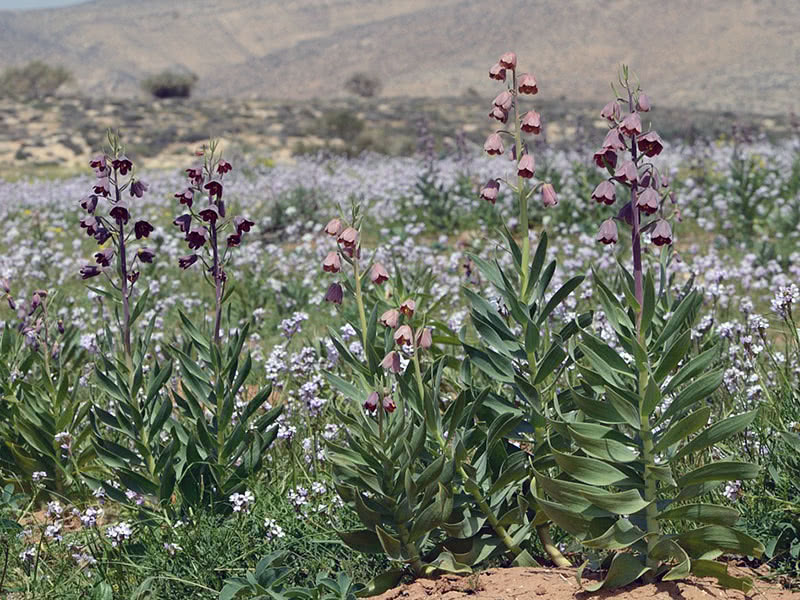
Section IV Rhinopetalum includes species of fritillaries originating from Western China and Afghanistan: Kamchatka fritillary, fritillaria biflora (chocolate lily) and fritillaria affinis (checker lily).The last one has interesting varieties: Limelight is up to 2 ft tall with green flowers and olive spots on them; Wayne Roderick was bred in China, this cultivar has an iridescent brown-emerald flower with green top and black-brown or red markings.
Section V Korolkowia has only one species fritillaria sewerzowii that is endemic to Central Asia (growing only there and nowhere else).

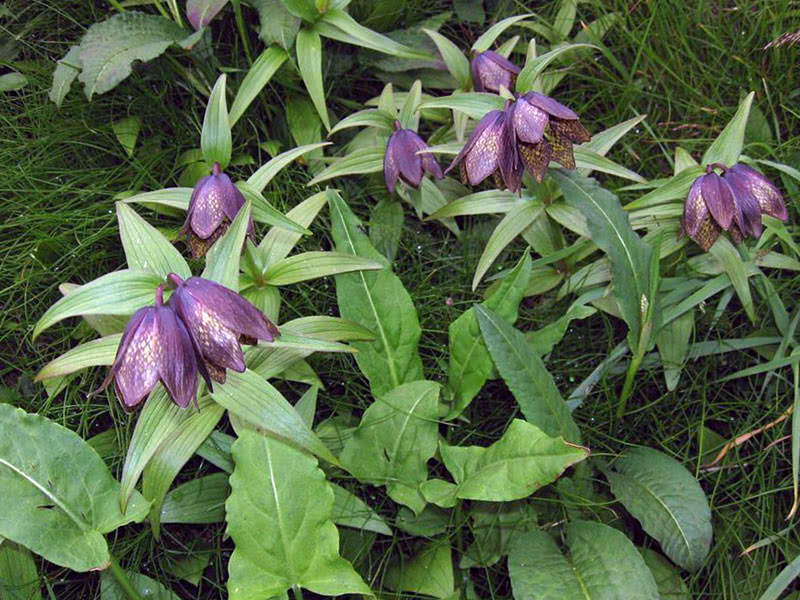
Section VI of Liliophiza is represented by species from North America. For example, Siskiyou fritillary is not higher than 6 inches, the flowers are long, golden yellow, in its inner side there are brown spots. In Europe, it is grown only in greenhouses.
Growing of fritillary in the garden
Let's talk about a plant that is deservedly called crown imperial, also known by names imperial fritillary, or Kaiser’s crown. Growing of imperial fritillary in cold climate areas became popular in the sixteenth century, but up to now this flower sometimes baffles the florists as despite all the efforts the flower may not bloom.
Imperial fritillary begins blooming as soon as the snow melts: lemon-yellow or juicy-orange flowers on tall peduncles after a dull winter look incredibly beautiful. They are well combined with other spring flowers. The fritillary bulb usually forms two peduncles at the base of which new bulbs are formed, but unfortunately the bulb produces few babies, so it is not cheap to buy fritillary bulbs in the store.
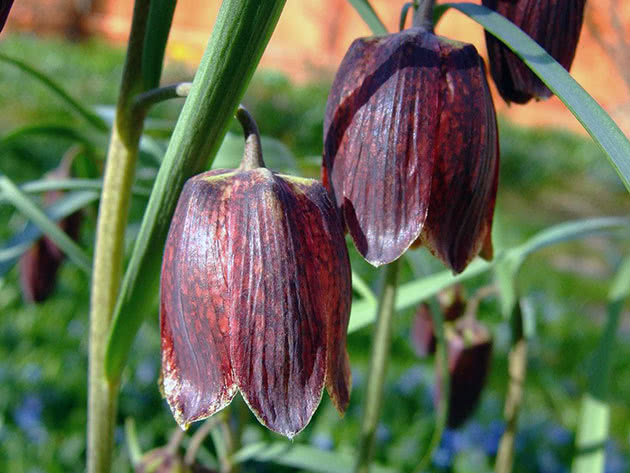
Imperial fritillary thrives in full sun, but it also grows well in the partial-shade. The soil should be light, fertile, moderately moist. It is very important to provide a good drainage.
Planting of fritillary
When to plant fritillary
When the growing season of fritillary is over, its bulbs are dug out and stored in a dry and ventilated room, until the bulb has formed roots: now it is time to plant it in the ground. Usually it happens in late August or early September. The bulbs of imperial fritillary do not have any protective covering scales, and they quickly wither. Therefore do not buy fritillary bulbs on late autumn sales: it is very likely that they are overdried and will not germinate. If for any reason, you do not have the opportunity to plant the fritillary bulbs on time, immerse them in a moist peat and place in the refrigerator in the vegetable box. If you do not plant the bulbs until the end of September, a later planting of fritillary bulbs may lead to the fact that next year they will not bloom at all. Before planting the bulbs should be disinfected with a solution of potassium permanganate, then lightly sprinkled with crushed charcoal.
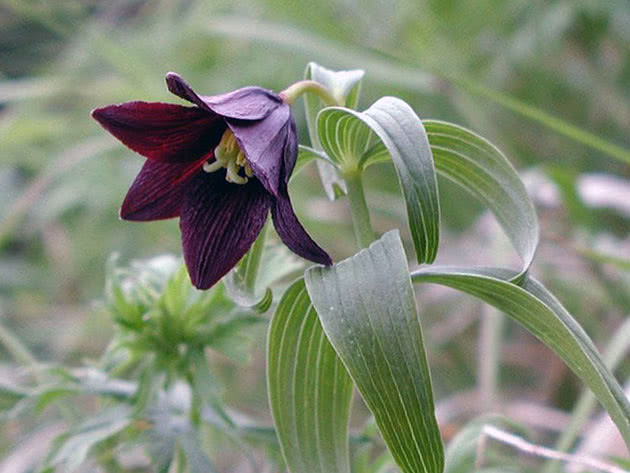
How to plant fritillary
Before planting, prepare a planting site: dig the soil up with adding sand in heavy soil, and, whatever the soil, add peat or humus to it. Fritillary also performs well if the soil contains lime or ash. The depth of planting from the bulb bottom should be 2-3 diameters of the bulb, it is about 8-10 inches. A layer of sand is poured on the bottom of the hole, but if the soil is heavy, it is better to replace the sand with moist peat. Then, the bulb is placed on sand or peat with a bottom downwards, the roots are carefully spread and the bulb is covered with soil. In fact, this is transplanting of fritillary rather than planting. But there is no point to argue about the terms if this does not change the essence.
Care of fritillary
How to care for fritillary in the garden
Fritillary has very low care requirements. But if you want to achieve a high quality of flowering, you should pay more attention to your fritillary. Planting and caring for fritillary are a wonderful learning experience for beginning flower growers. If you want to see a truly masterpiece of flower-growing art in your garden, you will have to spend some effort on caring for the imperial fritillary.
Watering of fritillary takes place in a dry summer. Make sure that the soil on the site does not get dried out too much. After the end of vegetation period, water the area 1-2 times a month for the fritillary bulbs not to be in too dry soil. Growing of fritillary also involves feeding the plants with dry fertilizers: the first time is in the third decade of April (mix one tablespoon of a fertilizer for flowering plants and one tablespoon of a fertilizer containing nitrogen, phosphorus, potassium with a bucket of humus, apply 8.8-11 pounds by a 1.6-2 inch layer per 11 ft²). The second dressing is carried out when fritillary fades: scatter 1 tablespoon of superphosphate and potassium sulfate per 11 ft², followed by watering.
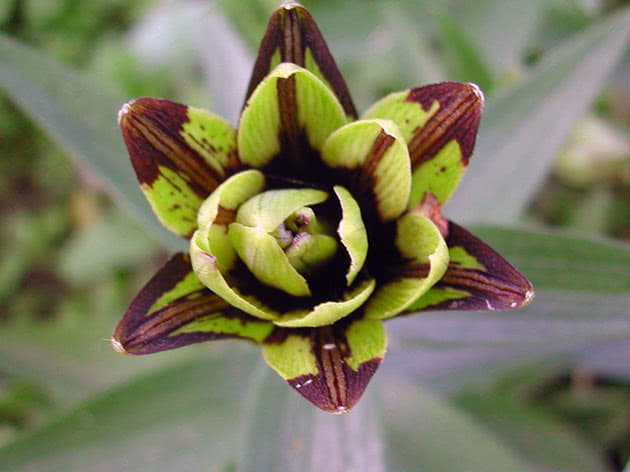
After each watering, weeding is necessary, but loosening of the soil is fraught with damage to the roots, so just mulch the soil on the site with a 1.2 inch layer of peat or humus immediately after planting, previously scattering the wood ash over the site.
Why fritillary does not bloom
The reason why your fritillaries do not want to bloom may be one of the following:
- too cool or very wet summer. Dig out the bulbs after flowering and try to warm them naturally before planting;
- too small bulbs. If the bulb is less than 2 inches in diameter, fritillary will not bloom as it is increasing the bulb’s mass;
- growth on one spot for a very long time. If you do not dig out the bulbs, they begin dividing and lose volume. Therefore, dig out mid-sized and large bulbs after flowering for the subsequent autumn planting, and you will surely get a beautiful flowering next year;
- wrong depth of planting: if the depth is insufficient, the plant becomes sensitive to weather changes (it can get frozen, and rot if it is rainy), and with too deep planting the bulb spends too many resources on germination and survival;
- inappropriate soil. Too light soil freezes in winter, clay soil absorbs too much moisture that leads to decay of the bulb. Take care of the proper soil composition and good drainage;
- snowless frosty winter: bulbs can be destroyed by frost. Cover the planting site of fritillary with a 4-8 inch layer of humus or peat before winter;
- keeping of the ovary after the fall of the petals. If the ovary is not removed in time, then all the nutrients will be spent on it, and not on the development of the bulb and the preparation for the next-year flowering.
Propagation of fritillary
In amateur floriculture, the vegetative method of natural bulb division is used to propagate fritillaries. As a rule, one bulb of imperial fritillary produces no more than two large babies, so this method is not the fastest, since being separated from the mother bulb and transplanted baby-bulb is grown in the soil for several years until its full flowering occurs. But this method is the most reliable.
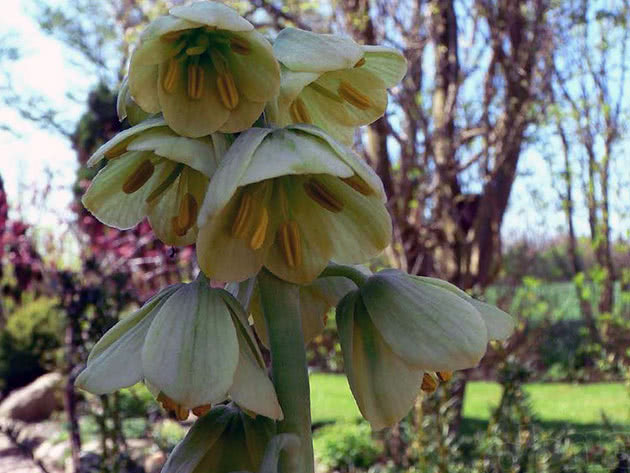
You can help fritillary form a baby: after a summer digging-out of fritillary make a shallow scrape of 0.8 inch in diameter with a sterile tool on the largest and healthy bulb on its fleshy part, then without processing let the wound air dry. Then place it in a clean dry sand and keep it in a dry room with good ventilation. When the bulb begins to grow roots (in late August or early September), it is treated with a fungicide and planted in the usual manner. The ovary that appear on the plant grown from this bulb should be removed, since in this growing season all the resources should be spent on the formation and development of babies. When digging out the bulb, be careful: a small baby can be easily overlooked.
Seed propagation of fritillary can be carried out only by professionals on an industrial scale.
Fritillary after flowering
When fritillaries have faded, they will still please you with their beautiful foliage for a while, but by the beginning of July fritillaries lose their ornamental beauty. It is time to dig out the bulbs when the aboveground part of the plant begins to turn yellow and die. But do not wait for the end of this process, since the bulb that is dormant at this time becomes an easy prey for pests.

When to dig out fritillary
When the leaves begin to turn yellow, dig out the bulbs, clear them from the dry scales, rinse them with warm water, soak them in pink potassium permanganate solution for half an hour, remove the rotten and other damaged areas, if necessary, by treating the cuts with a fungicide and sprinkling them with wood ash, place them in a dry ventilated room for wound healing.
Fritillary bulb storage
The bulbs are stored in a dry ventilated room, where the temperature is not higher than 86° F, from early July to late August, until the bulbs get the roots, and they get ready for autumn planting. Do not forget to inspect them from time to time, detecting rotten or damaged places.
